Abstract
An artificial retina neuron is proposed and implemented by CMOS technology. It can be used as an image sensor in the Artificial Intelligence (AI) field with the benefit of ultra-low power consumption. The artificial neuron can generate signals in spike shape with pre-designed frequencies under different light intensities. The power consumption is reduced by removing the film capacitor. The comparator is adopted to improve the stability of the circuit, and the power consumption of the comparator is optimized. The power consumption of the proposed CMOS neuron circuit is suppressed. The ultra-low-power artificial neuron with variable threshold shows a frequency range of 0.8–80 kHz when the input current is varied from 1 pA to 150 pA. The minimum DC power is 35 pW when the input current is 5 pA. The minimum energy of the neuron is 3 fJ. The proposed ultra-low-power artificial retina neuron has wide potential applications in the field of AI.
1. Introduction
Compared with the traditional Von Neumann architecture computer, the human brain shows stronger associative memory and thinking in images. It also has a greater potential ability than existing computers in solving complex problems such as function approximation, complex classification and clustering [1]. Moreover, compared with current existing computers, the human brain is not only more powerful, but it is also smaller and consumes less power. Therefore, the realization of the artificial neural network (ANN) to mimic the human brain intelligence has become a hot subject for research recently [2]. The human brain is composed of many complex interconnected neurons, and the information interaction between neurons is what forms the thinking ability. Designing a reasonable and efficient neuron unit is an important point for imitating the thinking ability of the human brain [3,4].
The first-generation ANN consists of threshold gates [5]. Its principle is using the threshold gate to judge the output result by counting the binary sum of the inputs. If the inputs’ summation is larger than the threshold value, it is considered to be high level (1); otherwise it is low level (0). It can be seen that the function of the first-generation ANN is very limited and that it can only process binary data. This is still far removed from the real biological neuron. The second-generation ANN is based on the encoding of the frequencies of the neuron pulses [6]. By stacking multiple layers of the neurons and applying a back propagation algorithm, a neural network can be constructed, which is known as deep learning neural network. This network is widely used in machine learning, brain-machine interfaces, image sensors, etc. [7]. Although the second-generation ANN is powerful, its energy consumption and efficiency are still not good enough compared with the biological network. Moreover, there is a big difference in the process of communicating with the spikes of neurons in the human brain in the underlying logic. Faced with these problems, the third-generation ANN has been proposed recently. Its neuron units are much closer to biological neurons, in that they can communicate with each other using spike signals. For this reason, it is also called spiking neural networks (SNN) [8]. The neuron in the SNN is not activated in every iteration state. It can be activated only when the membrane voltage reaches a certain value. When a spike neuron is activated, it generates a spike signal, which is transmitted to other neurons [9]. After the transmission, its membrane potential is changed accordingly. The spike generated by a biological neuron is used for encoding and processing the biological information. The artificial neural network shows a far superior ability in implementing real-time behavior systems or detailed large-scale simulations of neural systems than other digital tools and simulators [10].
The retina is a key tissue and can obtain visuosensory information efficiently, a subject that has been intensively studied recently [11,12,13]. By the pre-processing of optical information on the retina, the input light is transferred into the corresponding neural signal, which is encoded into the spike pattern for further transmission into a higher processor. Mimicking the biological retina, the artificial neuron model is designed based on CMOS technology, which is used to convert the optical pixel signals into specific spikes with certain frequencies. Billions of neurons with complex connections could build a large and efficient biological computing system. Figure 1 shows the schematic diagrams of the biological retinal system and the artificial ones. With the very large number of retinal cells in the artificial neuron structure, it is important to optimize the energy efficiency of the artificial neurons by reducing the power consumption. One of the most important issues of the artificial neuron in a neuromorphic system is how to decrease the power consumption.
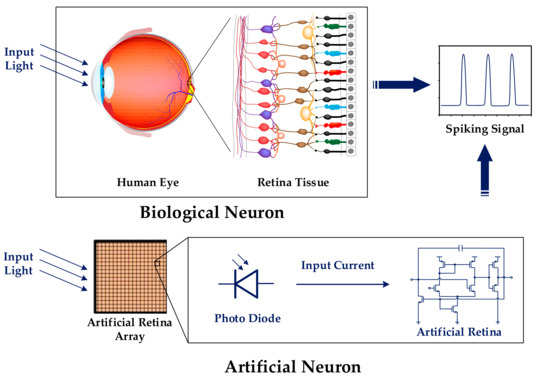
Figure 1.
Schematic diagram of the working mechanism of the artificial neurons mimicking the biological retina.
With the continuous investigation of the working mechanism of neurons, some artificial neuron circuits have been proposed. In [14], a neuron circuit based on the leaky integrate-and-fire (LIF) model is proposed. This circuit can realize the spike timing dependent plasticity (STDP) function of the neuron [15]. However, due to the existence of the multiple trans-conductance amplifiers in the circuit, the power is too high to be implemented practically. In [16], a circuit based on the Morris-Lecar (ML) model is proposed, as shown in Figure 2. Because the ML model is similar to the ion transport mechanism of the real neurons, the circuit can be used to mimic the real neurons [17]. However, due to the existence of many conductive paths in the circuit, its static power consumption is relatively high. Moreover, the adopted large capacitances Cm and CK limit its operating frequency. In [18], the circuit is simplified to reduce its power consumption, making the circuit display excellent merits in terms of its power consumption and area. However, the circuit is unstable and susceptible to the influences of the PVT variables.
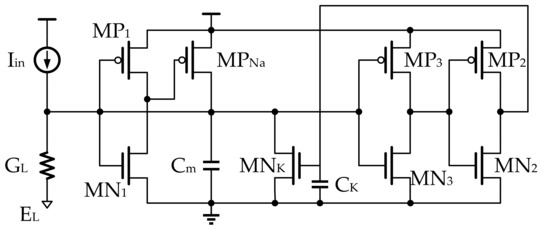
Figure 2.
Artificial neuron circuits based on ML model. As drawn in [16].
In this paper, a novel artificial neuron circuit is proposed that has ultra-low power while keeping robust variation tolerance. The circuit shows minimum layout area and can be integrated into large-scale arrays for mimicking the biological systems. The structure of the proposed artificial neuron circuit is described in the paper. The analysis and the results of the artificial neuron retina are reported.
2. The Principle of Axon-Hillock Circuit
Figure 3 shows the Axon-Hillock circuit, which is considered to be the traditional artificial neuron circuit [19]. It was proposed by Mead in 1989 and has been widely used in many works [20,21]. The input current Iin is commonly generated by a photodiode, in which different light intensities correspond to different magnitudes of the induced currents. The current Iin charges the membrane capacitor Cmem. The capacitor Cmem is the model of the retinal neuron’s membrane with the ionic current across it.
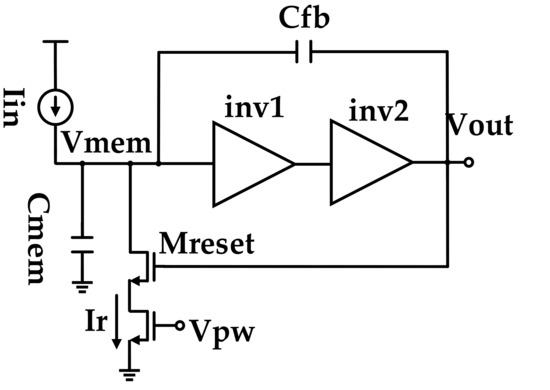
Figure 3.
Traditional Axon-Hillock structure. Iin is the current generated by the photodiode. Cmem is the capacitor of the neural membrane.
The amplifier in Figure 3 is the main part for the generation of the neuron spike, in which two invertors, inv1 and inv2, are included. At the initial state, both the values of Vout and Vmem are zero. The capacitor Cmem is charged by Iin, so that the voltage Vmem on Cmem is pulled up by the charging current. When Vmem exceeds the threshold voltage of inv1, the invertor flips and a spike signal is generated by the output port. At this moment, Vout is at a high enough level to turn on the reset transistor, Mreset. The reset current is set by Vpw. If it is larger than the input current Iin, the membrane capacitor is discharged. Therefore, Vmem is decreased continuously until it reaches the amplifier’s switching threshold again. In this way, a cycle is finished and the next cycle starts again.
The circuit in Figure 3 can imitate the characteristics of a stimulated retinal neuron, in which the output of the electric spike signal with a certain frequency can be generated and adjusted. It is a kind of classical SNN circuit. Based on the circuit, some research works propose useful solutions on how to reduce the power consumption. In [18], the Cmem capacitor is replaced by the parasitic part of the MOSFET of the first-stage inverter. Without the capacitor Cmem, the proposed solution can effectively reduce the power consumption of the neuron circuit. In the above design, the spike is related to the threshold voltage of inv1, which is determined by the process characteristics of the MOSFET device. However, the process parameters of MOSFET are generally variable in a certain scale, which easily leads to large deviation and affects the accuracy of the neural network calculation.
To diminish the possible influences of the process variations, a specific reference voltage Vthr is introduced, accompanied with a comparator for the implementation of the circuit, as shown in Figure 4 [10]. The adoption of the comparator can increase the process variation tolerance and improve the robustness of the artificial neuron. However, the power is increased according to the additional comparator and the related reference voltage Vthr. In this way, further improvement should be addressed to improve its characteristics. The following section shows the detailed information of the improvement.
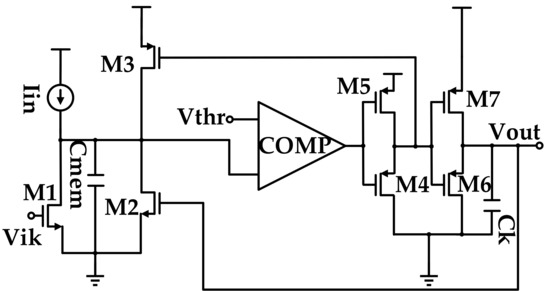
Figure 4.
The artificial neuron with the reference voltage Vthr. As drawn in [10].
3. Design of Novel Artificial Neuron
Based on the operation principle of the neuron, the new designed artificial neuron is shown in Figure 5. In the design, the adjustable voltage threshold is adopted. With the current charging, Iin can inspire the artificial neuron to generate the mimicked spikes with a certain frequency with ultra-low power consumption.
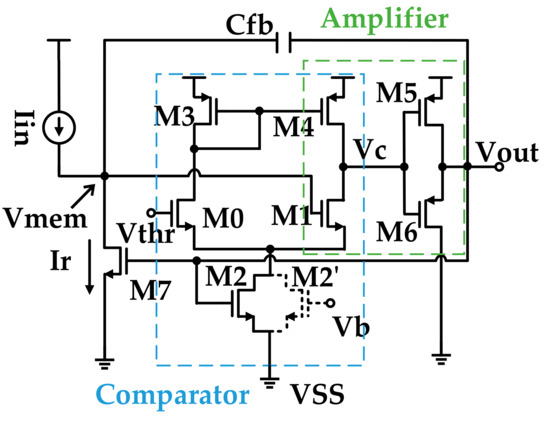
Figure 5.
Schematic of the artificial neuron designed in the work. The comparator and the amplifier share the branch of M1 and M4 together. M2 is the tail current source supplied by the Vout in this work. M2′ is the common tail current source supplied by the reference voltage Vb.
The setting of the voltage threshold is achieved by combining the comparator and the traditional Axon-Hillock circuit. As shown in Figure 5, the inverter with the two devices, M1 and M4, is the main part in the amplifier. At the same time, the inverter composed of M1 and M4 also operates in the comparator. The comparator with a mirror current source includes four transistors, M0, M1, M3 and M4.
With the positive input, the gate of M0 is the input of the reference threshold voltage Vthr. With the negative input, the gate of M1 is the input of the membrane voltage Vmem. When the voltage Vmem is higher than the threshold voltage Vthr, the comparator output voltage Vc is zero. Otherwise, when Vmem is lower than Vthr, Vc is set as Vdd. As the first stage inverter of the amplifier, M1 and M4 act as the same function as the inv1 of the Axon-Hillock in Figure 3. Therefore, if Vmem is increased to be the threshold voltage Vthr, the output of the artificial neuron reaches a high level by the output of the second invertor. For the proposed circuit in Figure 5, M1 and M4 are common-shared by the amplifier and the comparator. The common-shared design can effectively reduce the number of neuron circuits and therefore decrease the power consumption of the artificial neuron.
The power consumption is the key factor to be considered in the artificial neuron design [22]. To reduce the power consumption, one effective solution is to remove the membrane capacitor. As shown in Figure 5, the parasitic capacitance in the negative half cycle of the comparator is used as a part of the capacitance. At the initial state, the output voltage Vout is zero. Therefore, the feedback capacitor Cfb can also be regarded as the membrane capacitor and charged by the input current Iin. The output voltage Vout is connected with the gate of M7. Therefore, M7 is not only a switch of the reset current Ir, but also the current source of Ir.
To further reduce the power consumption, the tail current source of the comparator is effectively processed. In general, the offset voltage of the tail current source M2′ is provided by the reference voltage Vb. However, the branch of M2′, M0 and M3 is always at the conduction state because of the existence of Vthr and Vb. In this situation, the quiescent current always exists even without the input current. Therefore, the neural circuit still has a large amount of power loss during the sleeping state. To solve the problem, Vb is not used anymore.
As shown in Figure 5, the actual bias of the M2 is provided by the output voltage Vout of the artificial neuron. When there is no input current, Vout is zero and there i no static current through M2. The reduction of the tail current of the comparator can effectively decrease the power consumption. The operation process of the artificial neuron is shown in Figure 6. At the initial state, there is no light irritation. The output of the photodiode is zero. Therefore, the input current Iin is also zero without the light irritation. The membrane voltage Vmem is at a low level, which is lower than the threshold voltage Vthr. Therefore, the output voltage is low. No reset current is generated because the transistor M7 is at the off-state. As the input increases, Tr also shrinks, and the frequency of the output spike becomes higher.
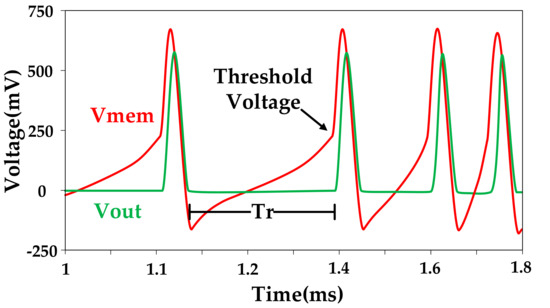
Figure 6.
The schematic diagram of the operation process of the artificial neuron. Vmem is the voltage of the membrane capacitor. Vout is the output of the artificial neuron. Tr is the time of the resting state.
When the light is switched on, the dc current Iin is produced by the photodiode. The capacitor Cfb is charged by Iin. Therefore, the membrane voltage Vmem is increased during the charging process. Before Vmem reaches the threshold voltage, the output voltage of the neural circuit Vout is kept at a low level. When Vmem exceeds Vthr, the Vc of the first stage inverter is switched to a low level quickly. Meanwhile, Vout of the second inverter is quickly changed from 0 to Vdd. The membrane voltage Vmem is pulled up to the level of Vout by the feedback capacitor to maintain the stable state of the comparator and the invertors. As Vout rises, the reset current source M7 is turned on and generates the reset current Ir. Because Ir is greater than the input current Iin, the membrane voltage Vmem decreases back to the threshold voltage Vthr. Thus, the output voltage of the comparator and artificial neuron are reset to their initial state. The re-closed reset current source M7 causes the feedback capacitor to be charged by input current again.
The rest time Tr is controlled by the input current, the feedback capacitance and the threshold voltage at the same time. The resting time is inversely proportional to the input current Iin, but proportional to the feedback capacitance Cfb and the reference voltage Vthr.
4. Result and Discussions
The proposed circuit is simulated with SMIC 40 nm CMOS process. The sizes of the transistors in the circuit are shown in Figure 7. In order to reduce the leakage currents of the transistors and suppress the static power consumption of the circuit, the channel length of M7 is set to 120 nm. The feedback capacitor Cfb is set to 5 fF. The power supply voltage is set to 500 mV and the reference voltage Vthr to 50 mV. The default value of the input current Iin is 5 pA.
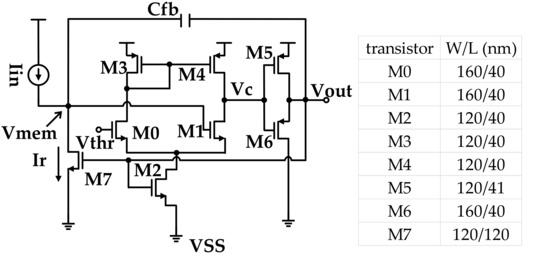
Figure 7.
Schematic diagram of the designed circuit, with the information of the sizes of the transistors.
Figure 8 shows the relationship between the output voltage Vout and the membrane voltage Vmem with different reference voltages Vthr. In the figure, the value of Vthr is varied from 30 mV to 70 mV. It can be seen that the flip point of the output is changed from 80 mV to 110 mV corresponding to the different Vthr values. This means that the reference voltage of the comparator has a proportional effect on the flipping point of the output, while the traditional one depends entirely on the process parameters of the inverter [14,15,16]. Adoption of the comparator reduces the influence of process parameters on the circuit flipping mechanism and improves the robustness of the circuit [10]. The sweep simulation with Vthr varied from 0 to 100 mV is conducted and the same tendency can be obtained, showing the circuit to have a wide operating range.
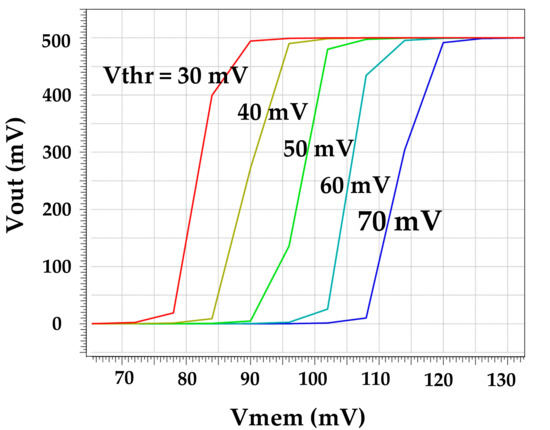
Figure 8.
The relationship between the output voltage Vout and the membrane voltage Vmem under different reference voltages Vthr varied from 30 mV to 70 mV.
As illustrated in Figure 5, the tail current of the comparator is cut off by the gate control on M2. The gate of M2 is directly connected with the output voltage. At this point, except for the weak leakage current of M3 and M7, there are no static currents on the other MOS transistors in the neural circuit. The static power consumption can be suppressed effectively. When the input current is not 0, the tail current source M2 is turned on by Vout, providing the current for the comparator. When Vmem exceeds Vthr, the two branches of the comparator are all switched on. All of the transistors in the neural circuit except M6 and M7 have current flowing through.
The total power consumption of the neural circuit and the energy loss by a spike signal in the range of input current from 1 to 150 pA are shown in Figure 9a. The power P is the product of the supply voltage Vdd and the DC current. E denotes the energy consumption per spike. With the increment of Iin, the charging speed of the feedback capacitor and the frequency of the state are accelerated. The minimum power is 35 pW with the input current 5 pA. The energy consumed by a spike is as low as 3 fJ. The cycle period is shrunk with the increasing of the input current Iin. In the tradeoff of the cycle time, the energy consumed by a spike signal is decreased, being opposite to the increment of the circuit power.
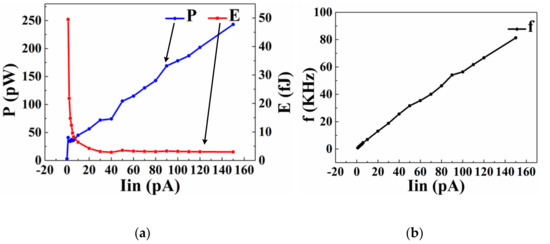
Figure 9.
Power consumption and the output frequency results of neural circuits. (a) The variation of the power P and spike energy E with the input current. (b) The variation of the spike frequency with the input current.
As shown in Figure 9b, the frequency of the spike signal is positively correlated with the input current. As the input current increases, the charging speed of the current on the feedback capacitor increases, which can significantly reduce the charging time of the membrane voltage. With the intensity of the input signal triggering the circuit, the output spike signal of the corresponding frequency is generated, which is the artificial neural source that imitates the working mechanism of the biological neuron, and it is also the core of the SNN signal encoding.
As shown in Figure 10, the artificial neurons in different schemes of the tail current sources (with M2 or with M2′) are compared in terms of the power consumption. The voltage offset of the tail current source of M2 is connected directly with the output voltage Vout. The tail current source consisting of M2′ is provided with a voltage offset by a separate voltage source. It can be seen, in Figure 10a, that the power consumption in the activated state of the Vout-biased tail current source (with M2) is significantly lower than that of the fixed-biased tail current source (with M2′). Similarly in Figure 10b, the power consumed by each spike in the circuit using the Vout-bias current source M2 is also reduced.
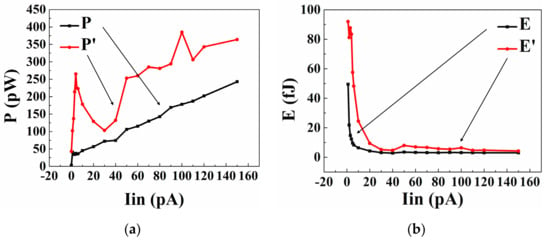
Figure 10.
The comparison of power and spike energy between the artificial neurons using the tail current source in M2 and M2′. (a) P is the power of the circuit with M2. P’ is the power of the circuit with M2′. (b) E is the spike energy of the circuit with M2. E’ is the spike energy of the circuit with M2′.
The neuron unit in SNN is not activated during the iterations, so the power consumption in the standby state accounts for the main part of the total power consumption. When the input current is 0, the DC current is 6.5 pA, which means a standby power consumption of 3.25 pw. However, if a fixed-biased tail current source M2′ is used, the DC current in the standby state increases to 80 pA due to the presence of the on-state current, which means a static power consumption of 40 pW. This is intolerable in a low-power neuron circuit. The use of a Vout-biased tail current source significantly reduces the overall power consumption of the circuit.
In order to verify the influence of the supply voltage Vdd and ambient temperature on the working frequency, the circuits are verified under the conditions of the feedback capacitance of 5 fF and the input current of 40 pA [20]. As shown in Figure 11a, with the increase of the power supply voltage Vdd, the emission frequency decreases. With the voltage range of 0.44–0.56 V, the variation of the frequency is approximately 1.5%. This means that the circuit is less affected by the power supply ripple and that the circuit is robust to the potential power supply voltage noise. The relationship between the firing frequency and the temperature is shown in Figure 11b. With the temperature increasing, the firing frequency tends to increase. The maximum variation of the emission frequency is approximately 6% in the range of 27–41 °C.
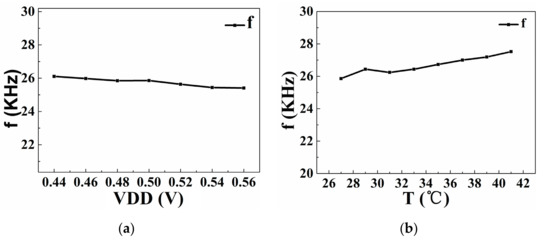
Figure 11.
The influence of the supply voltage and the temperature on the transmitting frequency. (a) The variation of the firing frequency with the supply voltage. (b) The variation of the firing frequency with the temperature.
The transient state simulation results of the neural circuits are shown in Figure 12. When the input current Iin is zero, the membrane voltage Vmem and the output of the artificial neuron remain at zero. When the input current is 5 pA (Iin in Figure 10), Vmem is increased with the charging by the input current. Afterwards, by the presence of the reset current source M7, Vmem is decreased. In this way, the spikes with certain frequency can be generated, as shown by the Vout result in Figure 12.
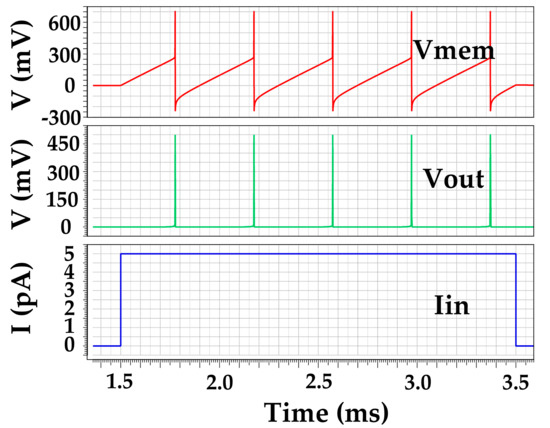
Figure 12.
The transient simulation results of neural circuits. Iin is the input current generated by the photodiode. Vout is the output of the artificial neuron. Vmem is the voltage of the membrane capacitor.
Figure 13 shows the layout of the designed neuron circuit. Thanks to the shrinking process size, its area is only 13 μm2, which makes it easy to implement the integration of the neuron arrays with thousands of the retina cells.
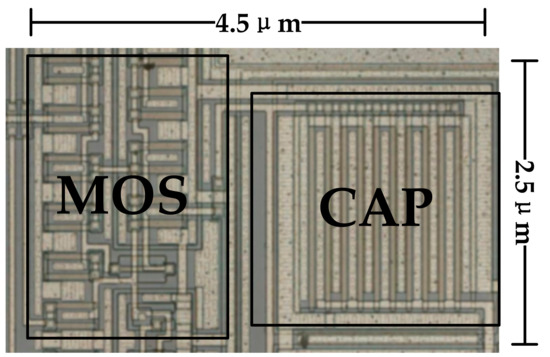
Figure 13.
The layout photo of the designed neuron circuit, with area 13 μm2.
The designed retinal circuit is fabricated based on standard CMOS 40-nm technology. Figure 14 shows the input and output waveforms of the retina with different input currents. Figure 14a shows the input current waveform. After the artificial retina processing, the output voltage is shown in Figure 14b. As the input changes from 6.3 pA to 9.4 pA, the interval between output spikes changes from 0.27 ms to 0.19 ms, that is, the frequency changes from 3.7 kHz to 5.3 kHz. For the performance of the fabricated chip, when the working voltage is 500 mV, the overall power consumption is 23 μW, which is mainly consumed by the reference voltage part. With the input current of 5 pA, and the temperature changing from 25 °C to 40 °C, the output spike frequency is varied within 2.3%. When the supply voltage is varied from 440 mV to 550 mV, the maximum output spike frequency is changed within 7.4%. The artificial neuron circuit can generate the spikes with the frequency ranging from 0.8–80 kHz when the input current is changed from 1 pA to 150 pA. It can be seen that the measured result coincides with the simulated ones.
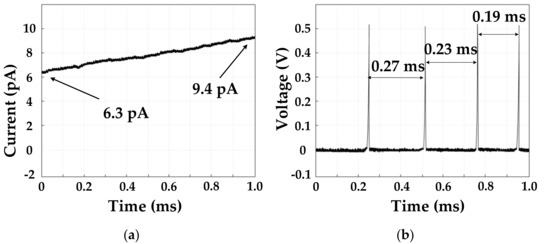
Figure 14.
The input and output waveforms of the designed artificial retinal neuron circuit based on the fabricated chip. The different spikes correspond to different input currents. (a) The waveform of the input current, in which the amplitude of the input current is increased from 6.3 pA to 9.4 pA. (b) The output waveform, in which the output spike voltage is generated by different time intervals.
To get a clear comparison with the other similar published works, Table 1 lists the key results of the designed circuit and the other published works. The results in the paper show better performance, especially in terms of the ultra-low power consumption. The power consumption of the design in the paper is approximately 35 pW, which is compatible with the result in [18]. In [18], the power supply voltage is 200 mV, while the voltage in this paper is 500 mV. The layout area of the design is also smaller than those of the other published results. Besides the low power consumption of the design, the robustness of the circuit is the other advantage. For [18], both the capacitor Cmem and the comparator are removed to obtain the low power consumption, with the sacrifice of the robustness of the circuit.

Table 1.
Comparison of the design in this paper and the design in others.
The adopted comparator can improve the stability of the circuit. The stability is an important parameter for the neurons used in the network. In a circuit without a comparator, the flip threshold is determined by the threshold of the MOS transistor itself, which is easily affected by the PTV variables. For example, the circuit in [18] is more susceptible to PVT factors without using a comparator. In the simulation results, the spike frequency fluctuates up to 20% by the temperature and up to 25% by the supply voltage. For the circuit in the paper, the fluctuation is controlled successfully within 6% by the temperature and within 1.5% by the voltage. It can be seen that the circuit in the paper can improve the temperature fluctuation by three times and the voltage fluctuation by 16 times when it is compared with [18].
5. Conclusions
The artificial retinal neuron is used to mimic the biological neuron in hardware implementation and is widely used in neuromorphic computing and image sensors. In this paper, a novel artificial retinal neuron with ultra-low power is proposed and demonstrated. With the combination of the comparator and the Axon-Hillock circuit, the artificial neuron not only achieves the setting of the voltage threshold, but also reduces the power loss of the circuit dramatically. In addition, the regulated tail current source by the output of the artificial neuron reduces the leakage current at the static state. The artificial neuron can generate spikes in frequency ranging from 0.8 to 80 kHz when the input current is varied from 1 pA to 150 pA. The minimum DC power is 35 pW at the 5 pA of the input current. The minimum energy consumption of a spike is as low as 3 fJ. It is verified that the proposed artificial neuron circuit can be used to convert the light intensity into the spike signal effectively with ultra-low power consumption.
Author Contributions
Q.W. conceived the idea and wrote most of this paper. G.P. wrote the paper together. Y.J. took part in the discussion, provided expertise and supervised the work. All authors have read and agreed to the published version of the manuscript.
Funding
This work was financially supported by a grant from National Natural Science Foundation of China (NSFC)—award number 61774078.
Conflicts of Interest
The authors declare no conflict of interest.
References
- Abiodun, O.I.; Jantan, A.; Omolara, A.E.; Dada, K.V.; Mohamed, N.A.; Arshad, H. State-of-the-Art in Artificial Neural Network Applications: A Survey. Heliyon 2018, 4, e00938. [Google Scholar] [CrossRef] [PubMed]
- Carvalho, G.; Pereira, M.; Kiazadeh, A.; Tavares, V.G. A Neural Network Approach Towards Generalized Resistive Switching Modelling. Micromachines 2021, 12, 1132. [Google Scholar] [CrossRef]
- Tacchino, F.; Macchiavello, C.; Gerace, D.; Bajoni, D. An Artificial Neuron Implemented on an Actual Quantum Processor. Npj Quantum Inf. 2019, 5, 1–8. [Google Scholar] [CrossRef]
- Kurenkov, A.; DuttaGupta, S.; Zhang, C.; Fukami, S.; Horio, Y.; Ohno, H. Artificial Neuron and Synapse Realized in an Antiferromagnet/Ferromagnet Heterostructure Using Dynamics of Spin–Orbit Torque Switching. Adv. Mater. 2019, 31, 1900636. [Google Scholar] [CrossRef] [PubMed]
- Rosenblatt, F. The Perceptron: A Probabilistic Model for Information Storage and Organization in the Brain. Psychol. Rev. 1958, 65, 386. [Google Scholar] [CrossRef]
- Russakovsky, O.; Deng, J.; Su, H.; Krause, J.; Satheesh, S.; Ma, S.; Huang, Z.; Karpathy, A.; Khosla, A.; Bernstein, M.; et al. Imagnet Large Scale Visual Recognition Challenge. Int. J. Comput. Vis. 2015, 115, 211–252. [Google Scholar] [CrossRef]
- Silver, D.; Huang, A.; Maddison, C.J.; Guez, A.; Sifre, L.; Van Den Driessche, G.; Schrittwieser, J.; Antonoglou, I.; Panneershelvam, V.; Lanctot, M.; et al. Mastering the Game of Go with Deep Neural Networks and Tree Search. Nature 2016, 529, 484–489. [Google Scholar] [CrossRef] [PubMed]
- Joubert, A.; Belhadj, B.; Temam, O.; Héliot, R. Hardware Spiking Neurons Design: Analog or Digital. In Proceedings of the 2012 International Joint Conference on Neural Networks, Brisbane, Australia, 10–15 June 2012; pp. 1–5. [Google Scholar] [CrossRef]
- Yang, J.Q.; Wang, R.; Ren, Y.; Mao, J.Y.; Wang, Z.P.; Zhou, Y.; Han, S.T. Neuromorphic Engineering: From Biological to Spike-Based Hardware Nervous Systems. Adv. Mater. 2020, 32, 2003610. [Google Scholar] [CrossRef]
- Indiveri, G.; Linares-Barranco, B.; Hamilton, T. Neuromorphic Silicon Neuron Circuits. Front. Neurosci. 2011, 5, 73. [Google Scholar] [CrossRef]
- Yang, X.; Xiong, Z.; Chen, Y.; Ren, Y.; Zhou, L.; Li, H.; Zhou, Y.; Pan, F.; Han, S. A Self-Powered Artificial Retina Perception System for Image Preprocessing Based on Photovoltaic Devices and Memristive Arrays. Nano Energy 2020, 78, 105246. [Google Scholar] [CrossRef]
- Lee, C.L.; Hsieh, C.C. A 0.5 V/1.8 V High Dynamic Range CMOS Imager for Artificial Retina Applications. IEEE Sens. J. 2015, 15, 6833–6838. [Google Scholar] [CrossRef]
- Yu, Z.; Liu, J.K.; Jia, S.; Zhang, Y.; Zheng, Y.; Tian, Y.; Huang, T. Toward the Next Generation of Retinal Neuroprosthesis: Visual Computation with Spikes. Engineering 2020, 6, 449–461. [Google Scholar] [CrossRef]
- Cruz-Albrecht, J.M.; Yung, M.W.; Srinivasa, N. Energy-Efficient Neuron, Synapse and STDP Integrated Circuits. IEEE Trans. Biomed. Circuits Syst. 2012, 6, 246–256. [Google Scholar] [CrossRef] [PubMed]
- Emelyanov, A.V.; Nikiruy, K.E.; Serenko, A.V.; Sitnikov, A.V.; Presnyakov, M.Y.; Rybka, R.B.; Sboev, A.G.; Rylkov, V.V.; Kashkarov, P.K.; Kovalchuk, M.V.; et al. Self-adaptive STDP-based learning of a spiking neuron with nanocomposite memristive weights. Nanotechnology 2019, 31, 045201. [Google Scholar] [CrossRef] [PubMed]
- Sourikopoulos, I.; Hedayat, S.; Loyez, C.; Danneville, F.; Hoel, V.; Mercier, E.; Cappy, A. A 4-Fj/Spike Artificial Neuron in 65 nm CMOS Technology. Front. Neurosci. 2017, 11, 123. [Google Scholar] [CrossRef] [PubMed]
- Morris, C.; Lecar, H. Voltage oscillations in the barnacle giant muscle fiber. Biophys. J. 1981, 35, 193–213. [Google Scholar] [CrossRef]
- Danneville, F.; Loyez, C.; Carpentier, K.; Sourikopoulos, I.; Mercier, E.; Cappy, A. A Sub-35 Pw Axon-Hillock Artificial Neuron Circuit. Solid State Electron. 2019, 153, 88–92. [Google Scholar] [CrossRef]
- Mead, C. Analog VLSI and Neural Systems; Addison-Wesley Longman Publishing Co.: Hoboken, NJ, USA, 1989. [Google Scholar]
- Olsson, J.A.M.; Hafliger, P. Mismatch Reduction with Relative Reset in Integrate-and-Fire Photo-Pixel Array. In Proceedings of the 2008 IEEE Biomedical Circuits and Systems Conference, Baltimore, MA, USA, 20–22 November 2008; pp. 277–280. [Google Scholar] [CrossRef]
- Ganguly, C.; Chakrabarti, S. A Leaky Integrate and Fire Model for Spike Generation in a Neuron with Variable Threshold and Multiple-Input–Single-Output Configuration. Trans. Emerg. Telecommun. Technol. 2019, 30, e3561. [Google Scholar] [CrossRef]
- Bai, Y.; Fan, D.; Lin, M. Stochastic-Based Synapse and Soft-Limiting Neuron with Spintronic Devices for Low Power and Robust Artificial Neural Networks. IEEE Trans. Multi Scale Comput. Syst. 2018, 4, 463–476. [Google Scholar] [CrossRef]
- Schuman, C.D.; Potok, T.E.; Patton, R.M.; Birdwell, J.D.; Dean, M.E.; Rose, G.S.; Plank, J.S. A Survey of Neuromorphic Computing and Neural Networks in Hardware. arXiv 2017, arXiv:1705.06963. [Google Scholar]
- Yao, E.; Basu, A. VLSI Extreme Learning Machine: A Design Space Exploration. IEEE Trans. Very Large Scale Integr. Syst. 2017, 25, 60–74. [Google Scholar] [CrossRef]
Publisher’s Note: MDPI stays neutral with regard to jurisdictional claims in published maps and institutional affiliations. |
© 2022 by the authors. Licensee MDPI, Basel, Switzerland. This article is an open access article distributed under the terms and conditions of the Creative Commons Attribution (CC BY) license (https://creativecommons.org/licenses/by/4.0/).